Learn how to sew a slipcover for a wingback chair with this step by step video tutorial.
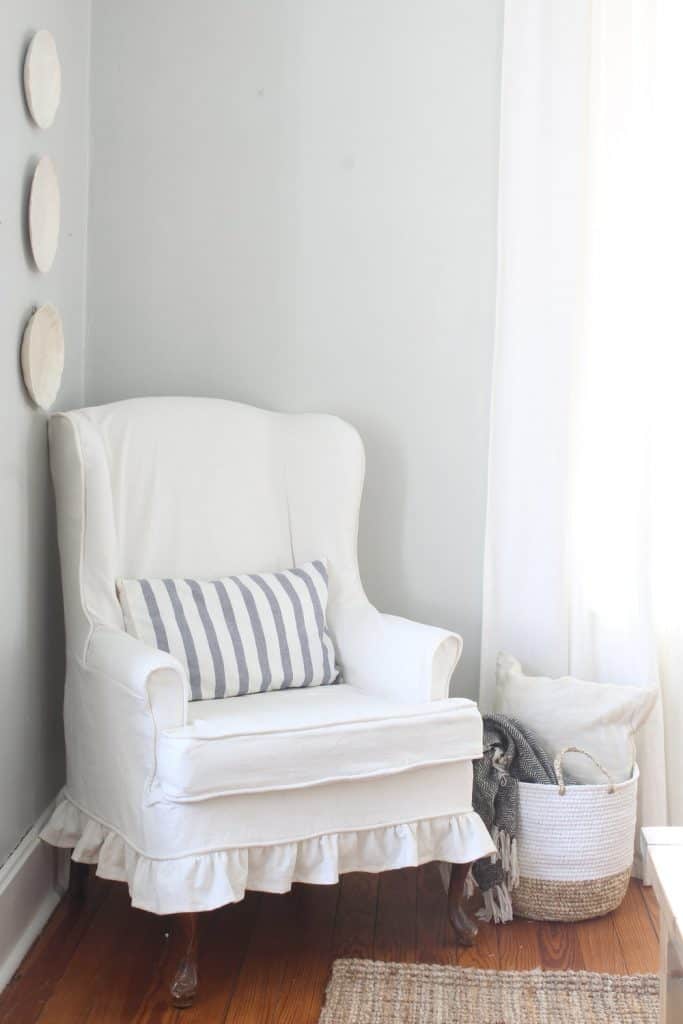
This post contains affiliate links for your shopping convenience. See my full disclosure HERE.
A Challenging Project
I have been sewing simple things for years now; dresses for my little girls, pillows, curtains, throw blankets and even simple slipcovers for our living room couches.
But, I must admit, this project challenged me.
This project was hard, but with patience and perseverance (and a few choice words) totally doable!
How to Slipcover a Wingback Chair Supplies
For this slipcover I used painter’s drop cloth that I bleached, a process I described in this post.
The drop cloth I use can be found HERE.
UPDATE MUST READ: I have heard from several readers that the brand of drop cloth you buy makes all the difference. I did not know this, since I have only ever used this brand from Amazon. Other brands turns gray and off white.
UPDATE PART TWO: Thanks to Lori, a lovely reader of my blog, I now know why some other brands won’t turn white. The drop cloths I recommend from Amazon are 100% cotton, so bleachable. Some brands are made with 50% polyester, so unbleachable. I knew people were having trouble with other brands, but now I actually know why!
Slipcovering is more about the process than an actual step by step tutorial.
To slipcover anything you just need to follow these rules
1. Follow the original seams and lines of the chair/couch/love seat
2. If you are adding piping, use the original chair as your guide. Put it in all the places that the original maker of the chair put it.
3. Pin the fabric tightly to the chair
4. Use a lot of pins and sew often.
This is not a quick process. You will want your chair near your sewing machine, so you can continually go back and forth to make sure everything is fitting okay.
You never want to pin and sew several seams at one time.
Always pin a little, sew it, and return to the chair to pin a little more.
Taking care to go slowly will ensure an excellent fit!
How To Slip Cover a Wingback Chair Instructions
To begin, I made enough piping to get me through the whole project.
To do this, I sandwiched 6/32″ cotton cord inside a four inch strip of bleached drop cloth.
I used a zipper foot to get the needle as close to the cord as possible, without sewing over it.
Next, I cut and draped all the pieces over the chair. (This will make waaay more sense in the video.) I cut pieces for the outside and inside of the wing, two pieces for the back, two pieces for the arms, two pieces for the front of the arms, two outside lower pieces, a piece for the front apron and a large piece for the front chair back (if that makes any sense at all).
I totally guesstimated all the sizes of the pieces.
Nothing has to be exact. The exactness will come with the pinning and sewing. 🙂
I started by overlapping the two back pieces and pinning them (right sides together) to the chair back piece.
It is really important to keep the chair back piece smooth and tight. It will the most visible in the finished slipcover.
Following the lines and seams of the original chair, I pinned the outside wing pieces to the back and to the inside wing pieces, which I also pinned to the front of the chair piece.
Have I lost you? It will make sense in the video.
You can see how many pins I used in this process. I wanted to be sure they would follow the lines of the chair, ensuring a nice fit.
I made sure the pins created a line for me to sew along.
While slipcovering I stop several times to be sure everything is still fitting.
Sometimes things may appear a bit wonky but might actually turn out when you pull it taut at another seam.
And remember that mine looked like it wasn’t going well halfway through, but turned out totally fine!
I could tell that I wasn’t going to have quite enough bleached drop cloth to finish my project, so I used unbleached drop cloth for the portion that would be hidden underneath the cushion.
Notice in the photo below how all the seams of my slipcover are along the original seams of the chair.
Use the piece as your guide.
This will allow you to slipcover anything.
After the main portion of the slipcover was finished, I added a ruffle and piping to the bottom edge to finish it off.
For the cushion, I created an envelope style cover, as opposed to using a zipper.
To make the pattern, I traced the shape of the cushion onto the drop cloth, leaving about a half inch on all sides for seam allowance.
For the bottom part of the cushion I cut two pieces that would overlap each ther for the cushion to fit inside.
I also cut a long strip that would go around the center of the cushion to join together the top and bottom pieces, with piping sandwiched between.
If you are on the fence about trying this, I encourage you to do it! As long as you go slow and check the fit often, you can totally do this.
You will be so proud of yourself for tackling the slipcover. 😉
You got this!
How to Sew a Slipcover for a Wingback Chair
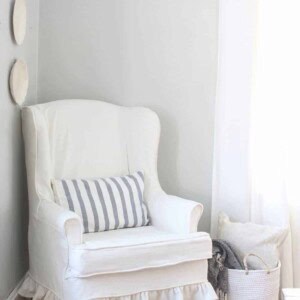
Equipment
- Sewing machine
Ingredients
- 100% cotton drop cloth
- sewing pins
Instructions
- For this slipcover I used painter’s drop cloth that I bleached (a process you can find on my blog!)
- This is not a quick process. You will want your chair near your sewing machine, so you can continually go back and forth to make sure everything is fitting okay. You never want to pin and sew several seams at one time. Always pin a little, sew it, and return to the chair to pin a little more. Taking care to go slowly will ensure an excellent fit!
- To begin, I made enough piping to get me through the whole project.
- To do this, I sandwiched 6/32″ cotton cord inside a four inch strip of bleached drop cloth. I used a zipper foot to get the needle as close to the cord as possible, without sewing over it.
- Next, I cut and draped all the pieces over the chair. (This will make waaay more sense in the video.) I cut pieces for the outside and inside of the wing, two pieces for the back, two pieces for the arms, two pieces for the front of the arms, two outside lower pieces, a piece for the front apron and a large piece for the front chair back (if that makes any sense at all).
- I totally guesstimated all the sizes of the pieces. Nothing has to be exact. The exactness will come with the pinning and sewing. I started by overlapping the two back pieces and pinning them (right sides together) to the chair back piece.It is really important to keep the chair back piece smooth and tight. It will the most visible in the finished slipcover.
- Following the lines and seams of the original chair, I pinned the outside wing pieces to the back and to the inside wing pieces, which I also pinned to the front of the chair piece.
Have I lost you? It will make sense in the video. - You can see how many pins I used in this process. I wanted to be sure they would follow the lines of the chair, ensuring a nice fit.
I made sure the pins created a line for me to sew along. - While slipcovering I stop several times to be sure everything is still fitting.Sometimes things may appear a bit wonky but might actually turn out when you pull it taut at another seam. And remember that mine looked like it wasn’t going well halfway through, but turned out totally fine!
- I could tell that I wasn’t going to have quite enough bleached drop cloth to finish my project, so I used unbleached drop cloth for the portion that would be hidden underneath the cushion. Notice in the photo below how all the seams of my slipcover are along the original seams of the chair. Use the piece as your guide. This will allow you to slipcover anything.
- After the main portion of the slipcover was finished, I added a ruffle and piping to the bottom edge to finish it off.
- For the cushion, I created an envelope style cover, as opposed to using a zipper. To make the pattern, I traced the shape of the cushion onto the drop cloth, leaving about a half inch on all sides for seam allowance. For the bottom part of the cushion I cut two pieces that would overlap each other for the cushion to fit inside.
- I also cut a long strip that would go around the center of the cushion to join together the top and bottom pieces, with piping sandwiched between. If you are on the fence about trying this, I encourage you to do it! As long as you go slow and check the fit often, you can totally do this.
Notes
- Follow the original seams and lines of the chair/couch/love seat
- If you are adding piping, use the original chair as your guide. Put it in all the places that the original maker of the chair put it.
- Pin the fabric tightly to the chair
- Use a lot of pins and sew often.
Nutrition information is automatically calculated, so should only be used as an approximation.
Pin it for later
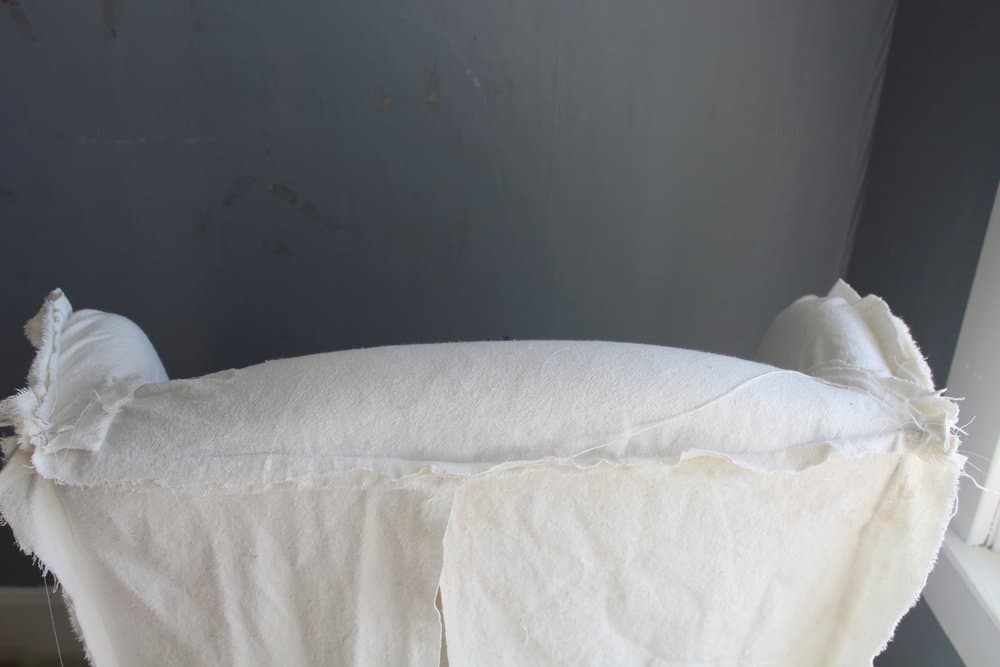
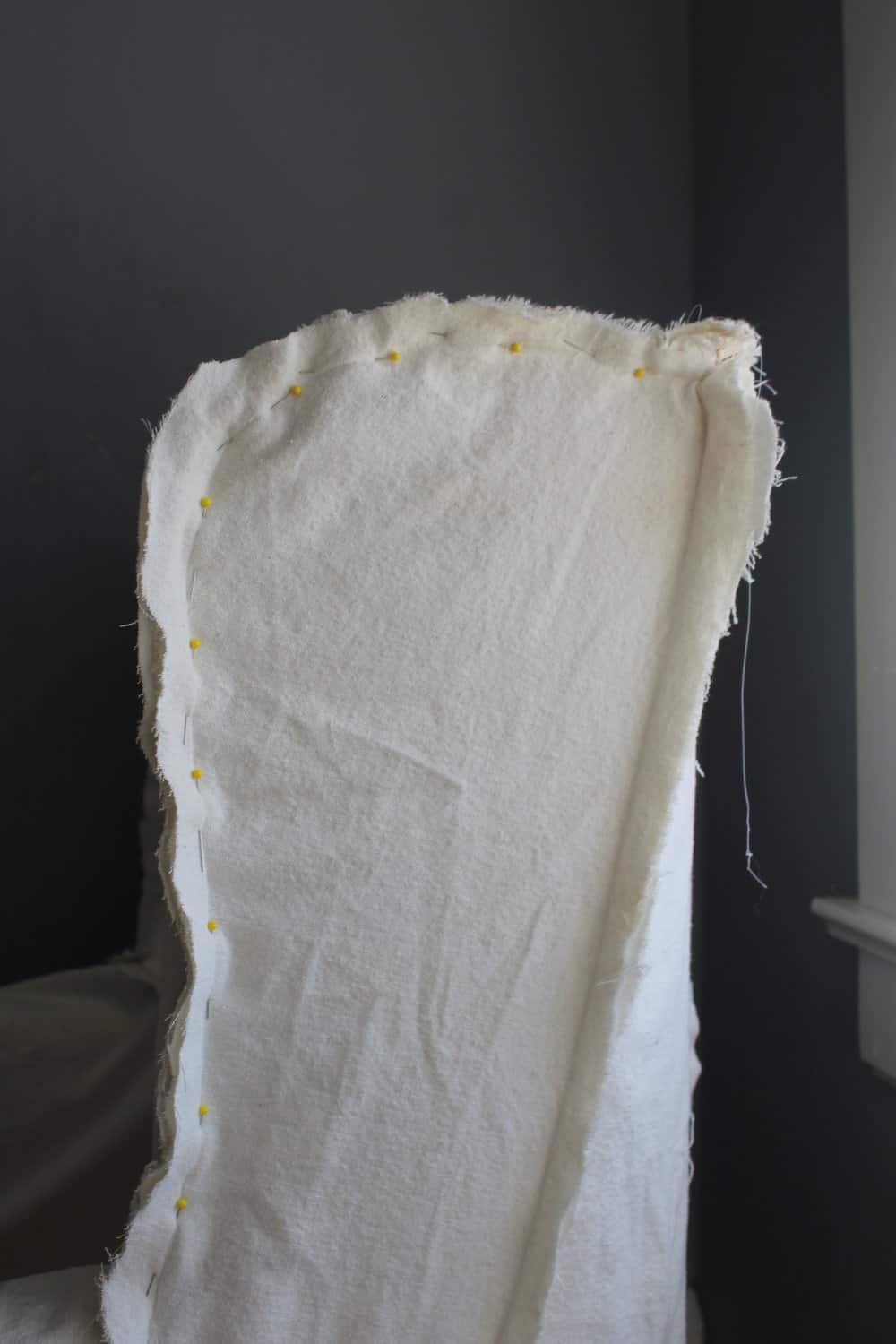
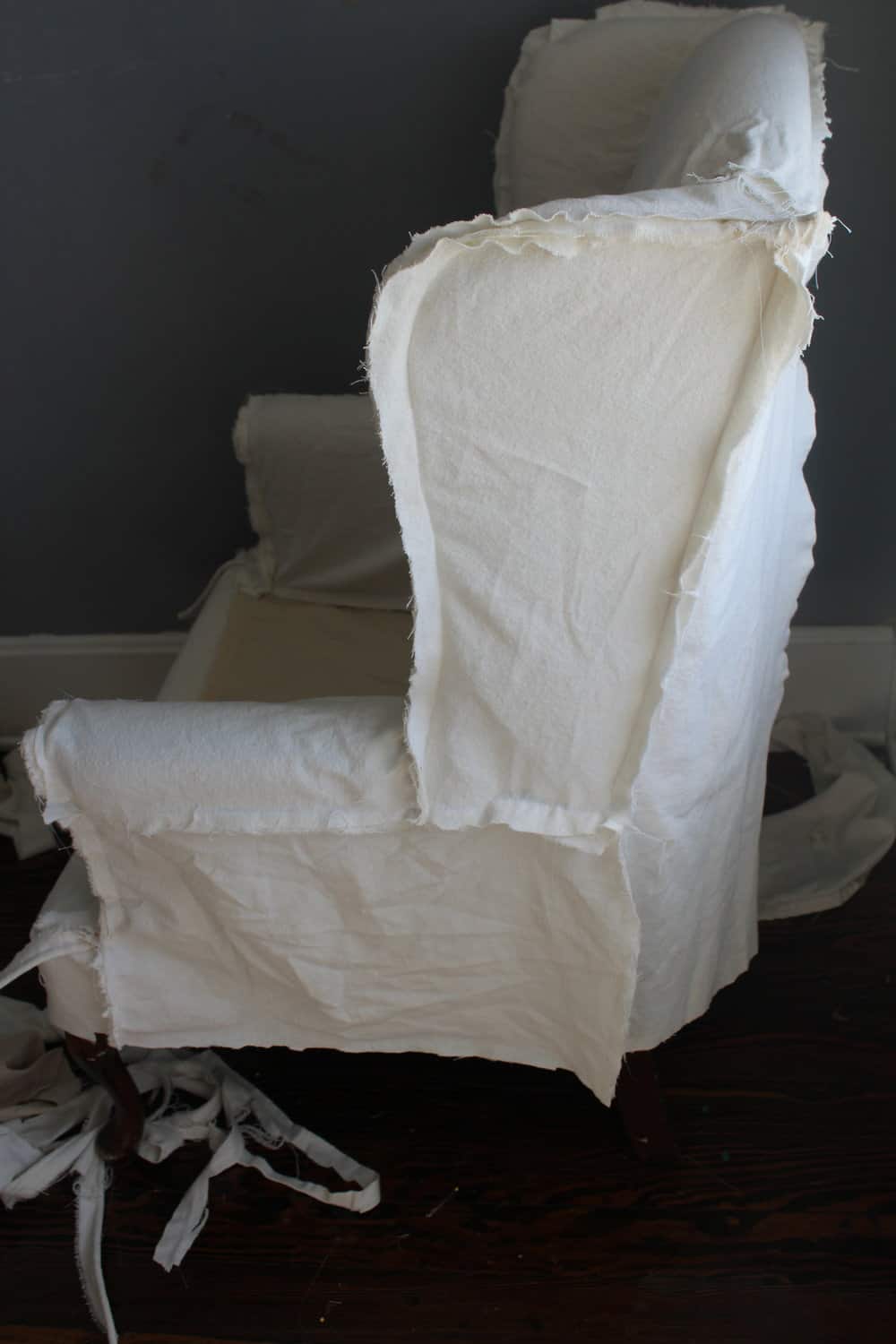
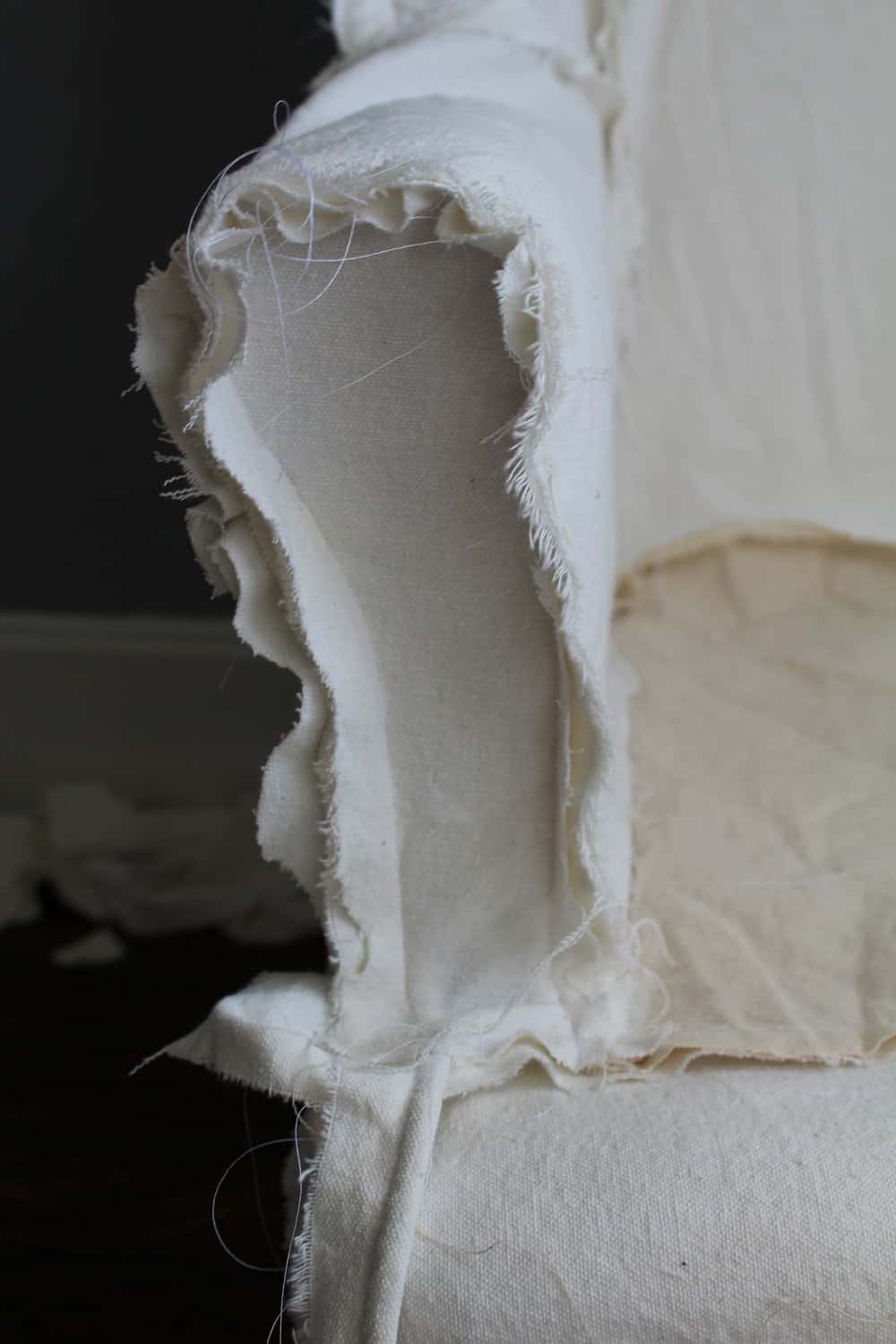
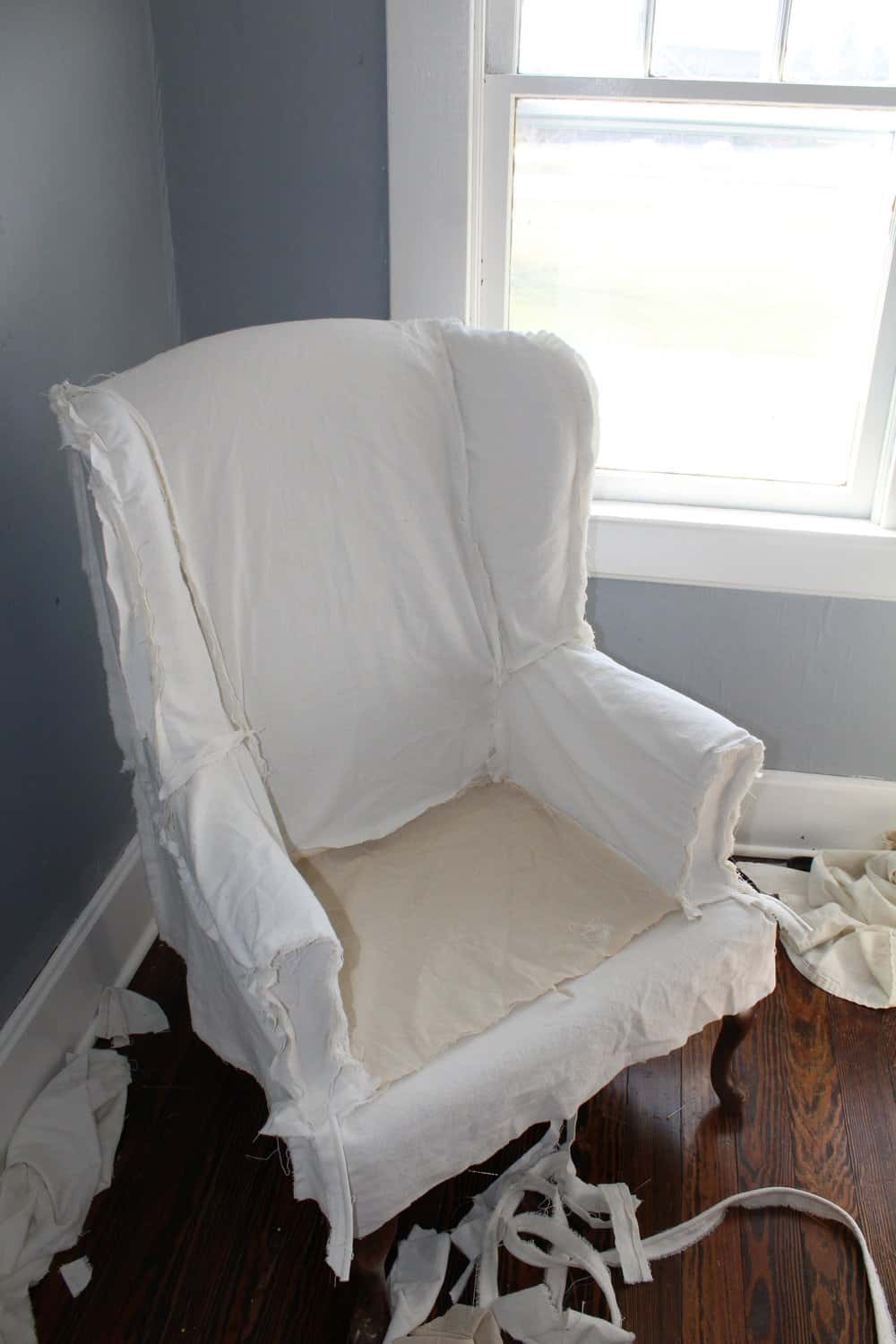
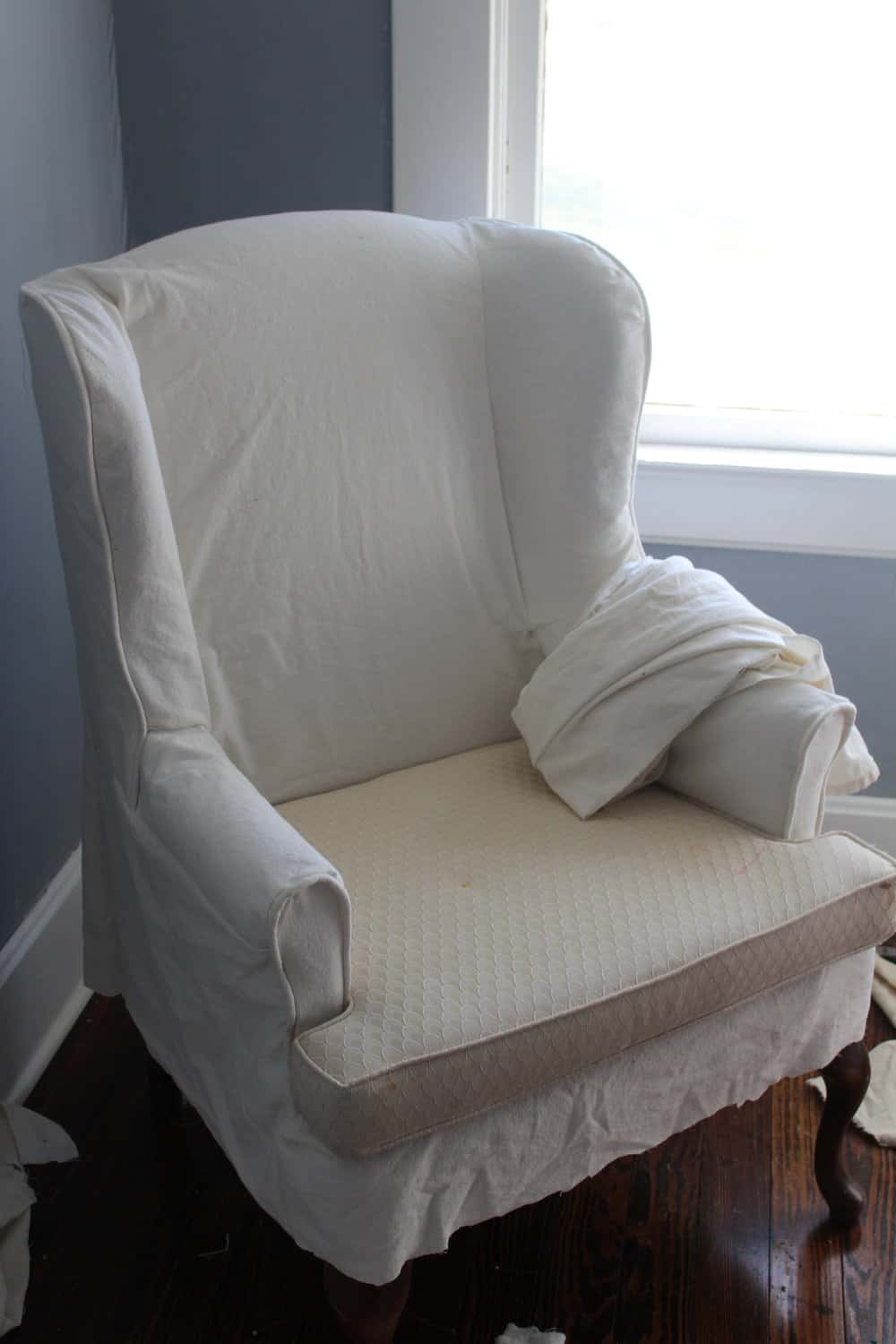
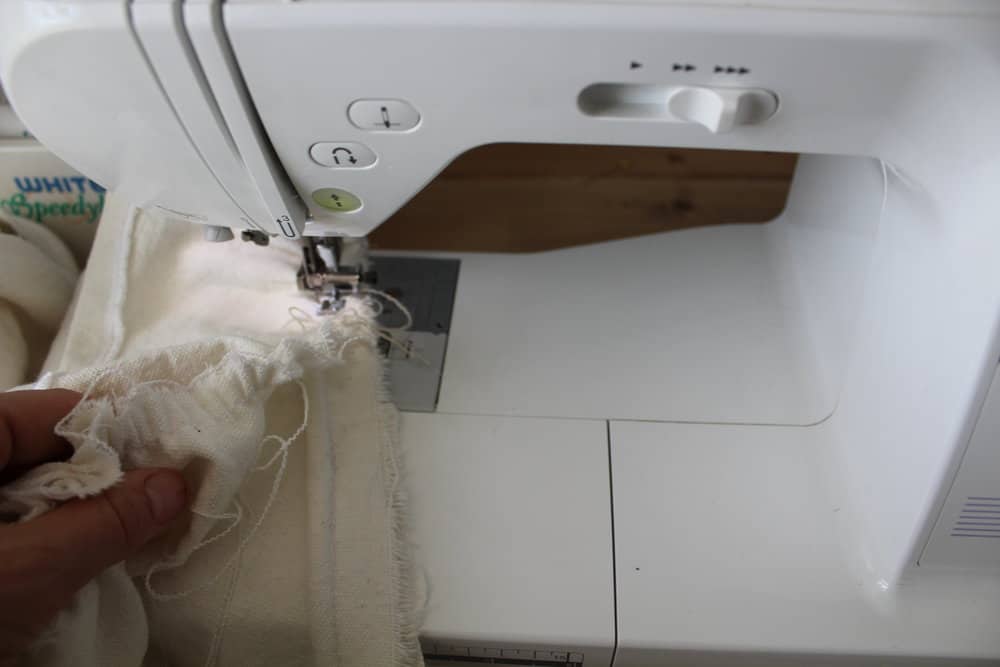
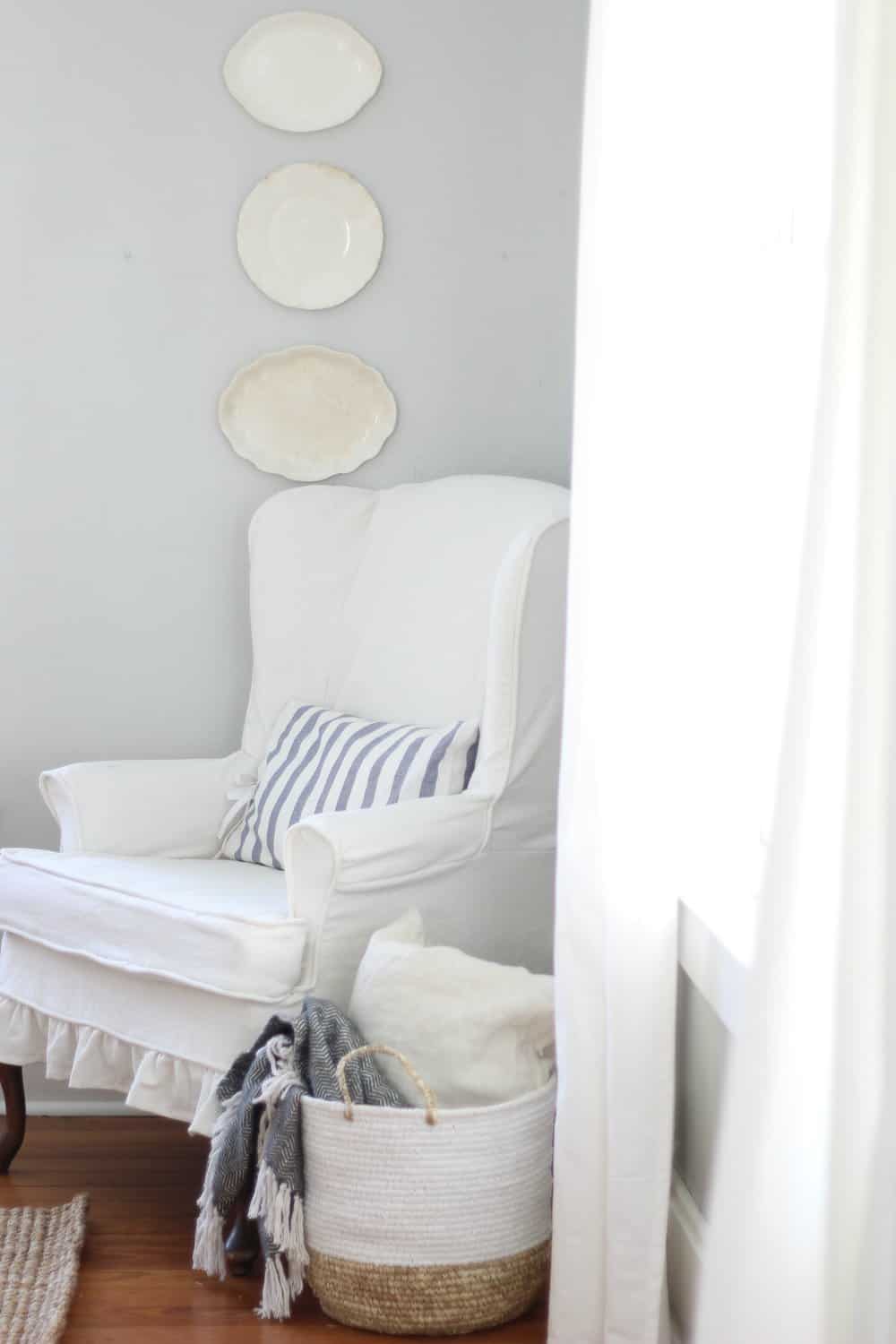
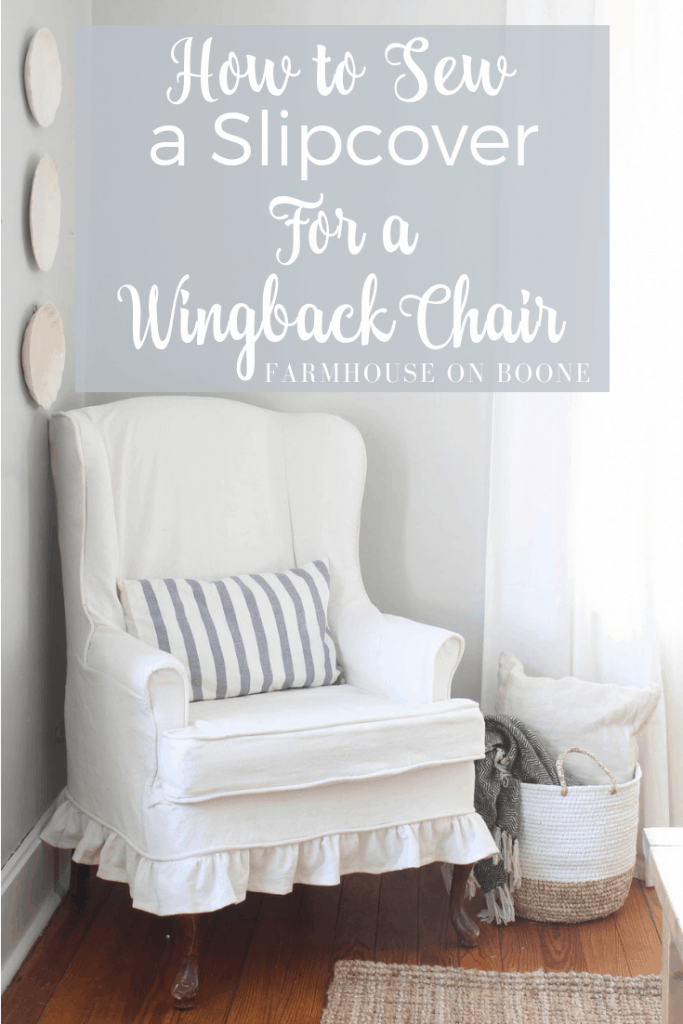
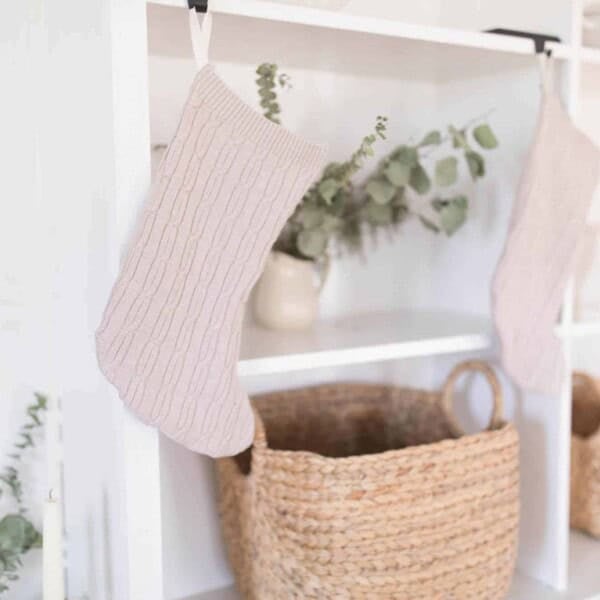


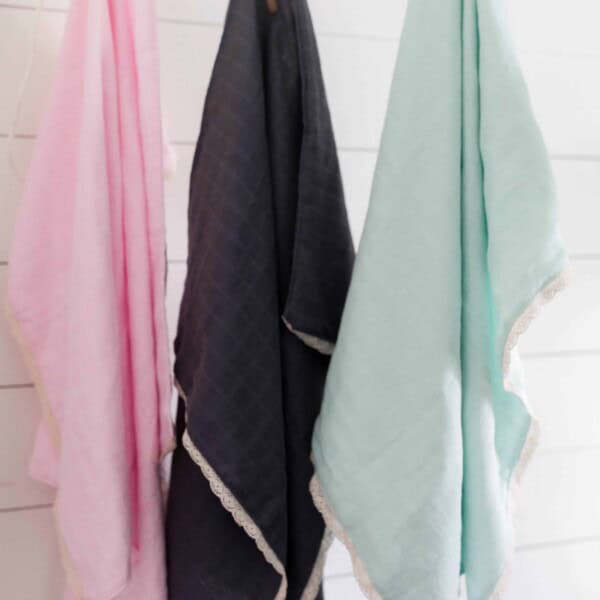






Hello again Lisa,
Thank you for answering my question. I realized you had a tutorial about how to wash and bleach the drop cloth after I asked you the question. However I do have one more question. How do you use the straight pins as a sewing guide since you can’t sew over them? That part has me stumped. Don’t you have to remove them as you sew? I wish you could give a demonstration on that part.
Thank you,
Diane
I just take each one out right before I reach it with my sewing machine. that way I can still follow the line. Does that make sense?
Yes. Thank you so much!
I love this sweet blog.
Thank you for sharing your talent.
I may have missed it in other posts, I’m curious what type of thread and needle you use when sewing on drop cloth.
LoriS
Hi Lisa,
After seeing how much seamstresses charge ($400 and up) to have a custom made slip cover for a wing-back chair, I decided to look up instructions to see how to do it myself and I’m so glad I came across your tutorial. Your instruction are so easy to follow and you make it look so easy. I hope I can do it! I do have a question. Should I wash and bleach the drop-cloth before starting to sew, or do I just start cutting and sewing?
Thank you so much,
Diane
Yep, definitely wash and bleach first! So glad my tutorial is helpful for you!
After trying 4 different store-bought slip covers, I realize my wing chair is just too wide. I do sew, but I was trying to speed up a room makeover. I am SOOOO glad I found your blog in my search!
Did your 9 x 12 drop cloth cover your chair and your piping?
Also, I will have to use the “tub” method for bleaching, that you mentioned. I have a front loader.
Thank you again, for such descriptive instructions, and all your encouraging comments along the way!
Wimberly
You inspired me to finally make a slipcover for our sofa. I had been putting it off because of the cost of fabric, then you came along and showed us the many uses of drop cloths. I didn’t bleach mine white but did add a few cups of bleach to lighten them up a little and washed/dried them 4 times. It was a challenge even for an experienced sewer as I am but in the end I am extremely pleased. Wish I could add a photo. Keep up the good work and inspiring others.
You have a wonderful touch! Thank you so much for sharing this post. Now, on to my slantomatic singer machine, circa 1960…
Oh nice! Does it still sew well? I bet it’s a lot more sturdy than modern ones!
Thank you so much for the wonderful video! I have been exploring slipcover tutorials and videos for a long time and yours was the first one that made sense to me.
My new wingback chair looks great and I am ready to slipcover everything in my house!
Thank you,
Jana
Thank you so very much for your excellent video. I am consumed with figuring out how to slip cover my sofa and yours is the best I have seen yet. Perhaps I have finally gained enough confidence to give it a try .
I’m going to have to see what else you’re up to excellent really excellent i’m going to have to see what else you’re up to . Excellent, really excellent and friendly approach. !!! 🙂
Excellent video! I am going to follow you everwhere!
Hi Lisa,
Thank you for your wonderful tutorial. You have inspired me to make slipcovers for my two wingback chairs. However the back of my chairs is just as visible as the front of my chairs in my space. Could you please show me the back of your chairs and how you fastened the two back panels together. I know there is more than one way to do it, But I would like to see how you did yours. Could you please show me a picture. Thank you very much